Resistance to Change: Leadership and Management Strategies
VerifiedAdded on 2020/05/16
|11
|2977
|133
Report
AI Summary
This report delves into the critical issue of employee resistance to change within organizations, highlighting its causes and consequences. It examines the human tendency to resist change, often driven by fear of the unknown, job security concerns, and fear of failure. The report explores the role of managers in addressing resistance, emphasizing the need for clear communication, training, and employee involvement in the change process. It analyzes the impact of power dynamics and ethical considerations in change management, including the importance of transparency and fair treatment. The report also discusses the effectiveness of various change management strategies, such as effective communication, involvement, and support, concluding that successful change management is essential for organizational survival and growth. It emphasizes that anticipating risks and fostering armed leadership are crucial to minimizing the negative impact of resistance and ensuring a smooth transition during the change lifecycle.
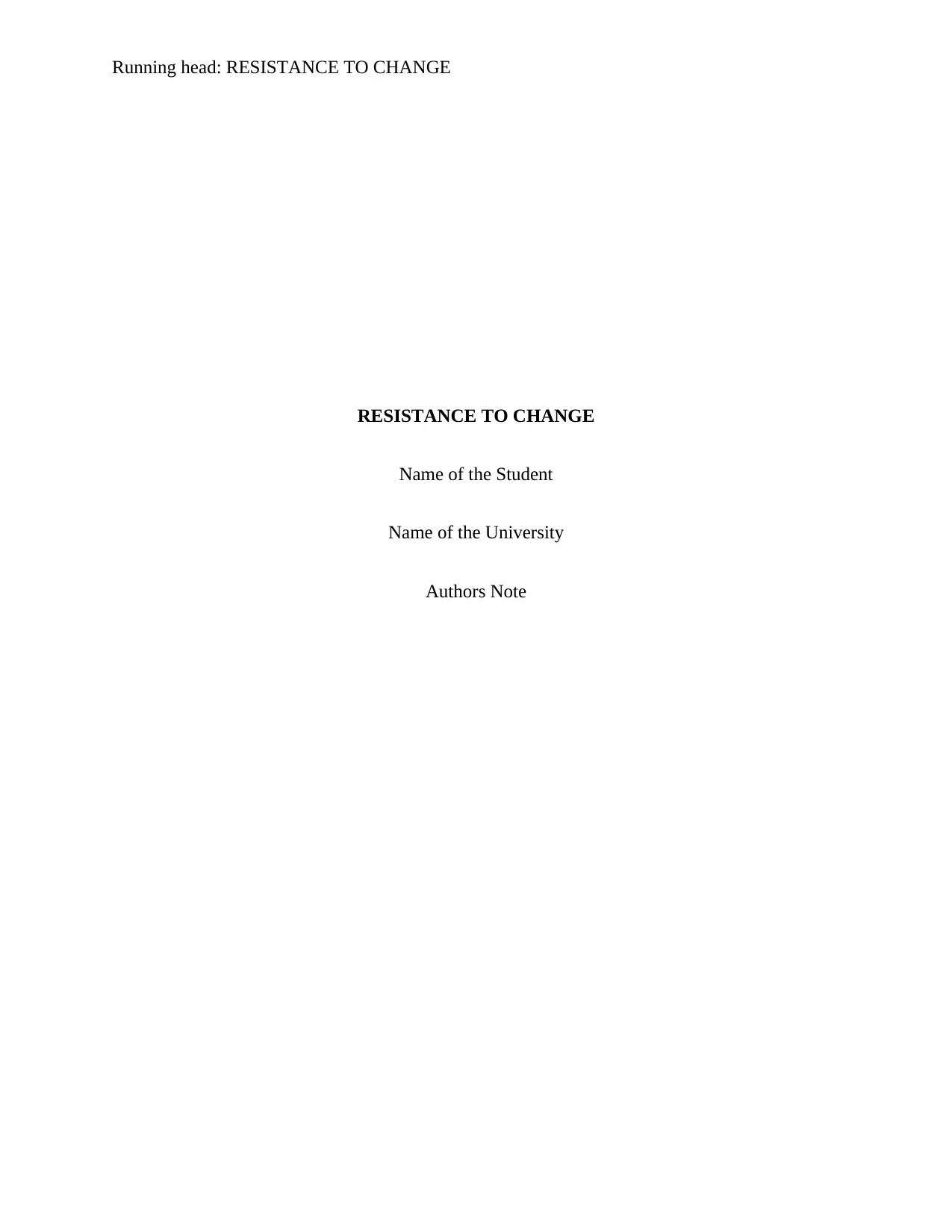
Running head: RESISTANCE TO CHANGE
RESISTANCE TO CHANGE
Name of the Student
Name of the University
Authors Note
RESISTANCE TO CHANGE
Name of the Student
Name of the University
Authors Note
Paraphrase This Document
Need a fresh take? Get an instant paraphrase of this document with our AI Paraphraser
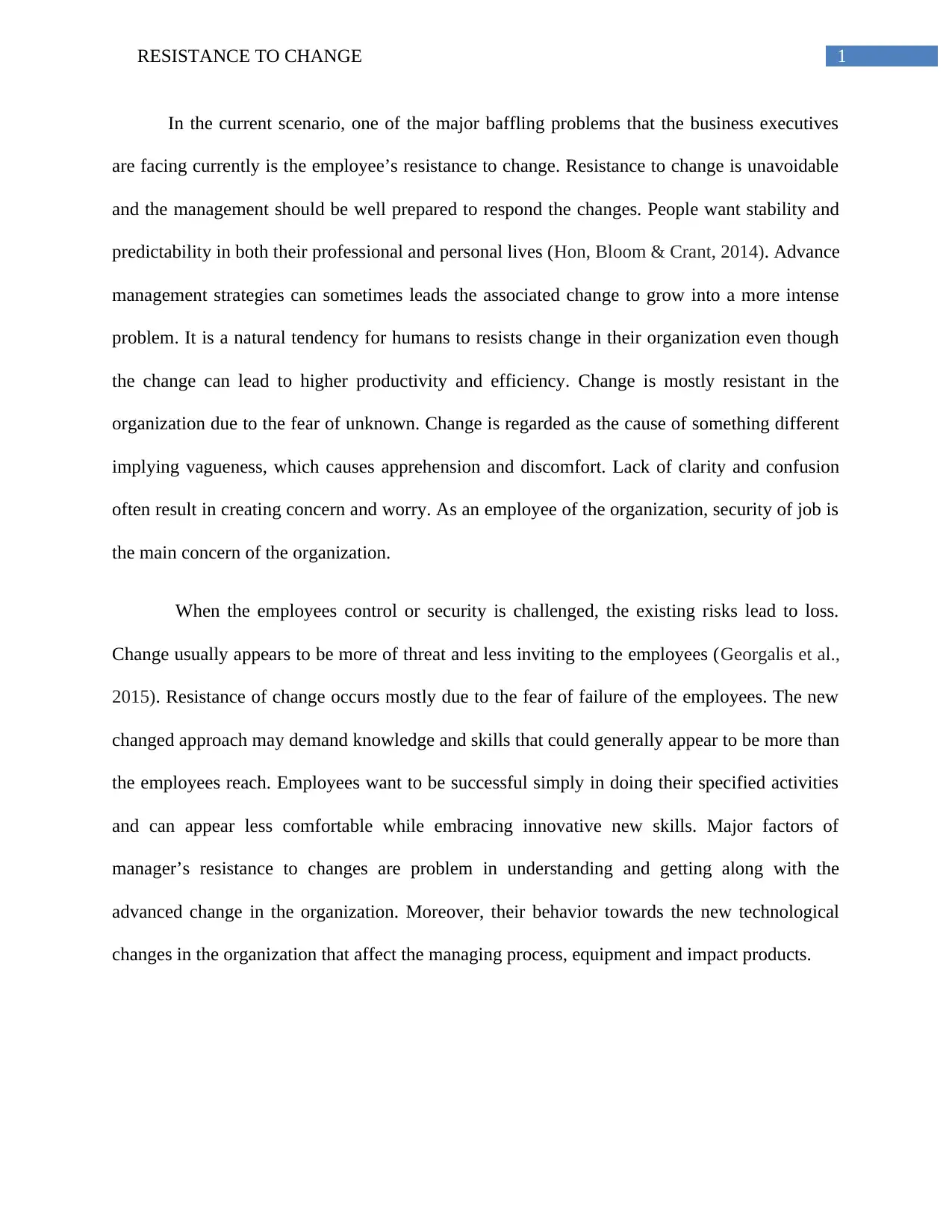
1RESISTANCE TO CHANGE
In the current scenario, one of the major baffling problems that the business executives
are facing currently is the employee’s resistance to change. Resistance to change is unavoidable
and the management should be well prepared to respond the changes. People want stability and
predictability in both their professional and personal lives (Hon, Bloom & Crant, 2014). Advance
management strategies can sometimes leads the associated change to grow into a more intense
problem. It is a natural tendency for humans to resists change in their organization even though
the change can lead to higher productivity and efficiency. Change is mostly resistant in the
organization due to the fear of unknown. Change is regarded as the cause of something different
implying vagueness, which causes apprehension and discomfort. Lack of clarity and confusion
often result in creating concern and worry. As an employee of the organization, security of job is
the main concern of the organization.
When the employees control or security is challenged, the existing risks lead to loss.
Change usually appears to be more of threat and less inviting to the employees (Georgalis et al.,
2015). Resistance of change occurs mostly due to the fear of failure of the employees. The new
changed approach may demand knowledge and skills that could generally appear to be more than
the employees reach. Employees want to be successful simply in doing their specified activities
and can appear less comfortable while embracing innovative new skills. Major factors of
manager’s resistance to changes are problem in understanding and getting along with the
advanced change in the organization. Moreover, their behavior towards the new technological
changes in the organization that affect the managing process, equipment and impact products.
In the current scenario, one of the major baffling problems that the business executives
are facing currently is the employee’s resistance to change. Resistance to change is unavoidable
and the management should be well prepared to respond the changes. People want stability and
predictability in both their professional and personal lives (Hon, Bloom & Crant, 2014). Advance
management strategies can sometimes leads the associated change to grow into a more intense
problem. It is a natural tendency for humans to resists change in their organization even though
the change can lead to higher productivity and efficiency. Change is mostly resistant in the
organization due to the fear of unknown. Change is regarded as the cause of something different
implying vagueness, which causes apprehension and discomfort. Lack of clarity and confusion
often result in creating concern and worry. As an employee of the organization, security of job is
the main concern of the organization.
When the employees control or security is challenged, the existing risks lead to loss.
Change usually appears to be more of threat and less inviting to the employees (Georgalis et al.,
2015). Resistance of change occurs mostly due to the fear of failure of the employees. The new
changed approach may demand knowledge and skills that could generally appear to be more than
the employees reach. Employees want to be successful simply in doing their specified activities
and can appear less comfortable while embracing innovative new skills. Major factors of
manager’s resistance to changes are problem in understanding and getting along with the
advanced change in the organization. Moreover, their behavior towards the new technological
changes in the organization that affect the managing process, equipment and impact products.
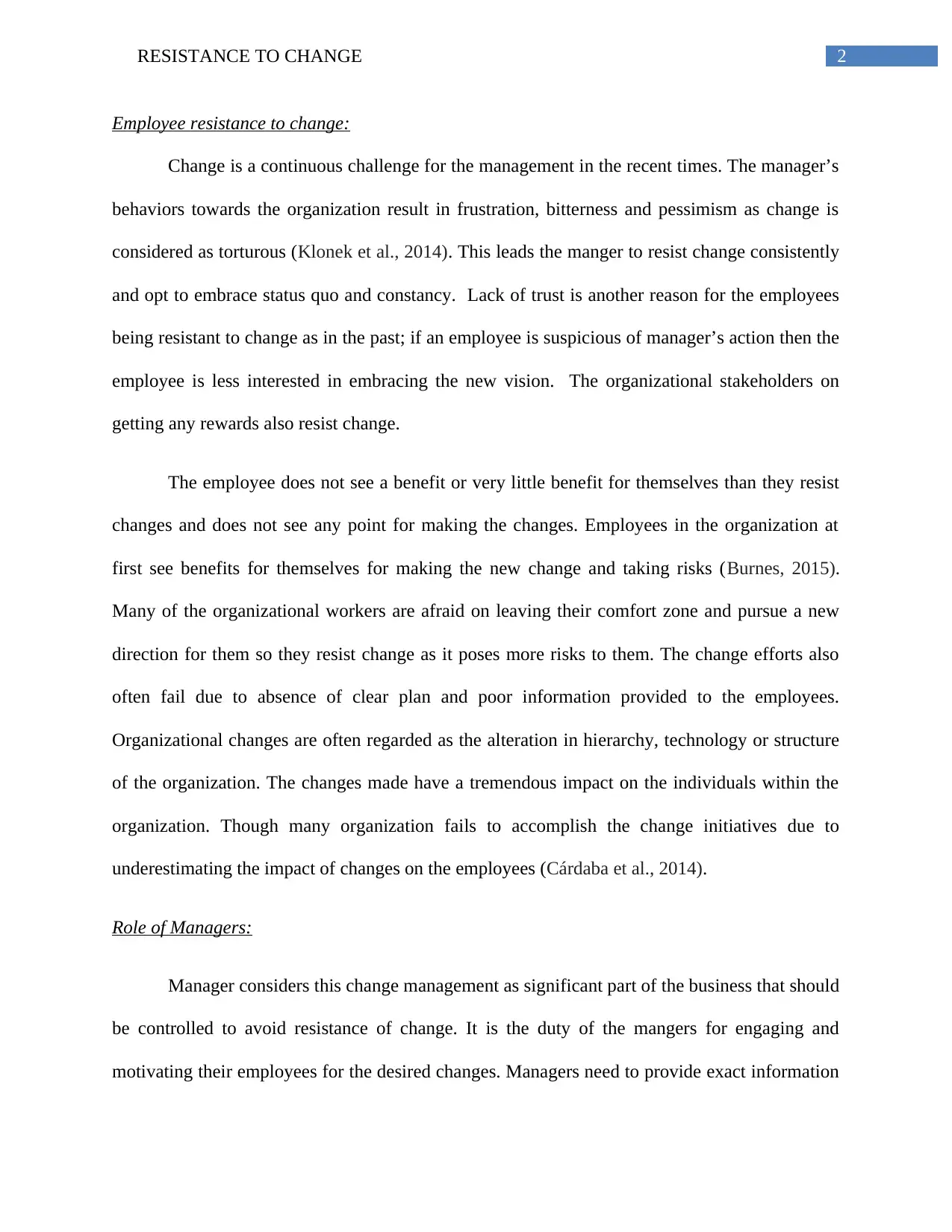
2RESISTANCE TO CHANGE
Employee resistance to change:
Change is a continuous challenge for the management in the recent times. The manager’s
behaviors towards the organization result in frustration, bitterness and pessimism as change is
considered as torturous (Klonek et al., 2014). This leads the manger to resist change consistently
and opt to embrace status quo and constancy. Lack of trust is another reason for the employees
being resistant to change as in the past; if an employee is suspicious of manager’s action then the
employee is less interested in embracing the new vision. The organizational stakeholders on
getting any rewards also resist change.
The employee does not see a benefit or very little benefit for themselves than they resist
changes and does not see any point for making the changes. Employees in the organization at
first see benefits for themselves for making the new change and taking risks (Burnes, 2015).
Many of the organizational workers are afraid on leaving their comfort zone and pursue a new
direction for them so they resist change as it poses more risks to them. The change efforts also
often fail due to absence of clear plan and poor information provided to the employees.
Organizational changes are often regarded as the alteration in hierarchy, technology or structure
of the organization. The changes made have a tremendous impact on the individuals within the
organization. Though many organization fails to accomplish the change initiatives due to
underestimating the impact of changes on the employees (Cárdaba et al., 2014).
Role of Managers:
Manager considers this change management as significant part of the business that should
be controlled to avoid resistance of change. It is the duty of the mangers for engaging and
motivating their employees for the desired changes. Managers need to provide exact information
Employee resistance to change:
Change is a continuous challenge for the management in the recent times. The manager’s
behaviors towards the organization result in frustration, bitterness and pessimism as change is
considered as torturous (Klonek et al., 2014). This leads the manger to resist change consistently
and opt to embrace status quo and constancy. Lack of trust is another reason for the employees
being resistant to change as in the past; if an employee is suspicious of manager’s action then the
employee is less interested in embracing the new vision. The organizational stakeholders on
getting any rewards also resist change.
The employee does not see a benefit or very little benefit for themselves than they resist
changes and does not see any point for making the changes. Employees in the organization at
first see benefits for themselves for making the new change and taking risks (Burnes, 2015).
Many of the organizational workers are afraid on leaving their comfort zone and pursue a new
direction for them so they resist change as it poses more risks to them. The change efforts also
often fail due to absence of clear plan and poor information provided to the employees.
Organizational changes are often regarded as the alteration in hierarchy, technology or structure
of the organization. The changes made have a tremendous impact on the individuals within the
organization. Though many organization fails to accomplish the change initiatives due to
underestimating the impact of changes on the employees (Cárdaba et al., 2014).
Role of Managers:
Manager considers this change management as significant part of the business that should
be controlled to avoid resistance of change. It is the duty of the mangers for engaging and
motivating their employees for the desired changes. Managers need to provide exact information
⊘ This is a preview!⊘
Do you want full access?
Subscribe today to unlock all pages.

Trusted by 1+ million students worldwide
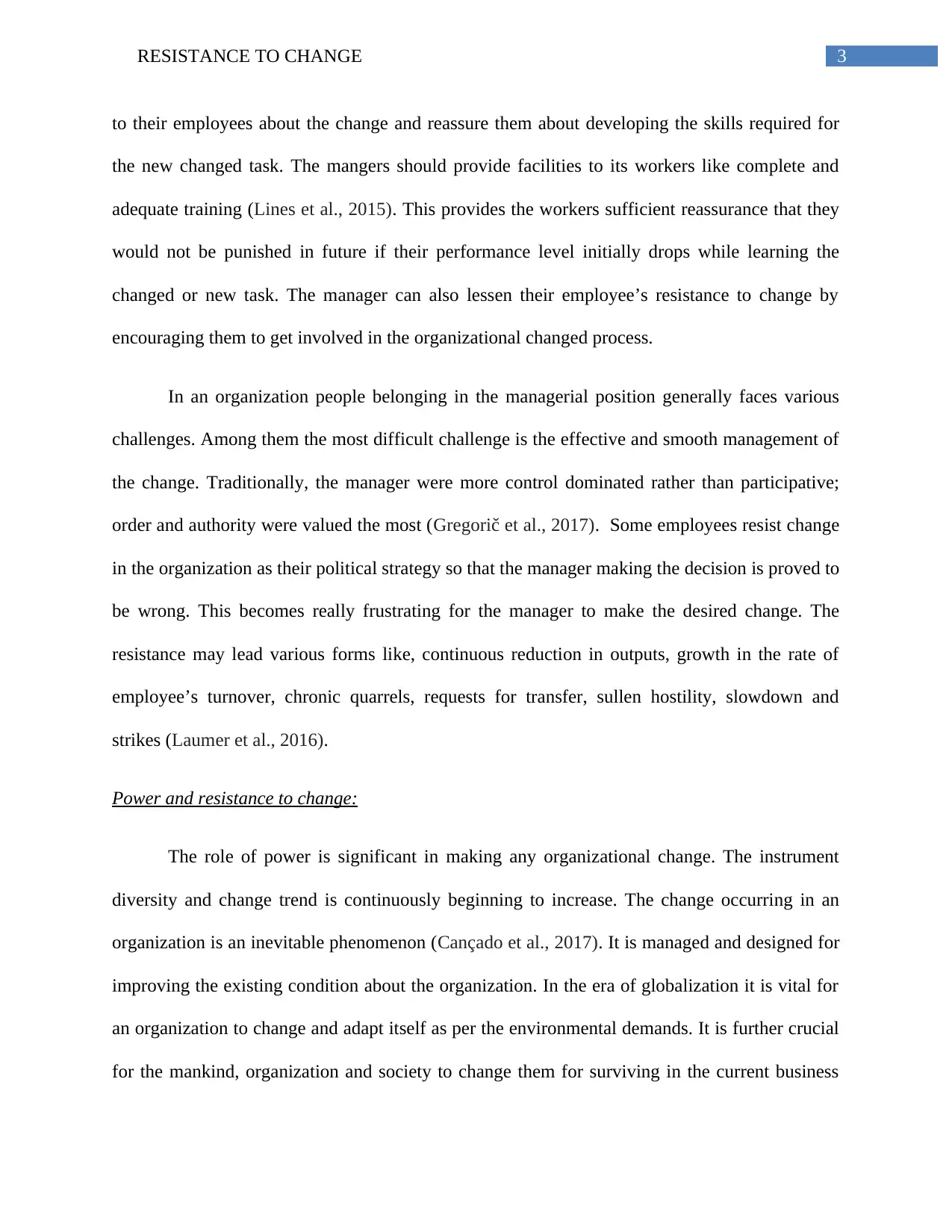
3RESISTANCE TO CHANGE
to their employees about the change and reassure them about developing the skills required for
the new changed task. The mangers should provide facilities to its workers like complete and
adequate training (Lines et al., 2015). This provides the workers sufficient reassurance that they
would not be punished in future if their performance level initially drops while learning the
changed or new task. The manager can also lessen their employee’s resistance to change by
encouraging them to get involved in the organizational changed process.
In an organization people belonging in the managerial position generally faces various
challenges. Among them the most difficult challenge is the effective and smooth management of
the change. Traditionally, the manager were more control dominated rather than participative;
order and authority were valued the most (Gregorič et al., 2017). Some employees resist change
in the organization as their political strategy so that the manager making the decision is proved to
be wrong. This becomes really frustrating for the manager to make the desired change. The
resistance may lead various forms like, continuous reduction in outputs, growth in the rate of
employee’s turnover, chronic quarrels, requests for transfer, sullen hostility, slowdown and
strikes (Laumer et al., 2016).
Power and resistance to change:
The role of power is significant in making any organizational change. The instrument
diversity and change trend is continuously beginning to increase. The change occurring in an
organization is an inevitable phenomenon (Cançado et al., 2017). It is managed and designed for
improving the existing condition about the organization. In the era of globalization it is vital for
an organization to change and adapt itself as per the environmental demands. It is further crucial
for the mankind, organization and society to change them for surviving in the current business
to their employees about the change and reassure them about developing the skills required for
the new changed task. The mangers should provide facilities to its workers like complete and
adequate training (Lines et al., 2015). This provides the workers sufficient reassurance that they
would not be punished in future if their performance level initially drops while learning the
changed or new task. The manager can also lessen their employee’s resistance to change by
encouraging them to get involved in the organizational changed process.
In an organization people belonging in the managerial position generally faces various
challenges. Among them the most difficult challenge is the effective and smooth management of
the change. Traditionally, the manager were more control dominated rather than participative;
order and authority were valued the most (Gregorič et al., 2017). Some employees resist change
in the organization as their political strategy so that the manager making the decision is proved to
be wrong. This becomes really frustrating for the manager to make the desired change. The
resistance may lead various forms like, continuous reduction in outputs, growth in the rate of
employee’s turnover, chronic quarrels, requests for transfer, sullen hostility, slowdown and
strikes (Laumer et al., 2016).
Power and resistance to change:
The role of power is significant in making any organizational change. The instrument
diversity and change trend is continuously beginning to increase. The change occurring in an
organization is an inevitable phenomenon (Cançado et al., 2017). It is managed and designed for
improving the existing condition about the organization. In the era of globalization it is vital for
an organization to change and adapt itself as per the environmental demands. It is further crucial
for the mankind, organization and society to change them for surviving in the current business
Paraphrase This Document
Need a fresh take? Get an instant paraphrase of this document with our AI Paraphraser
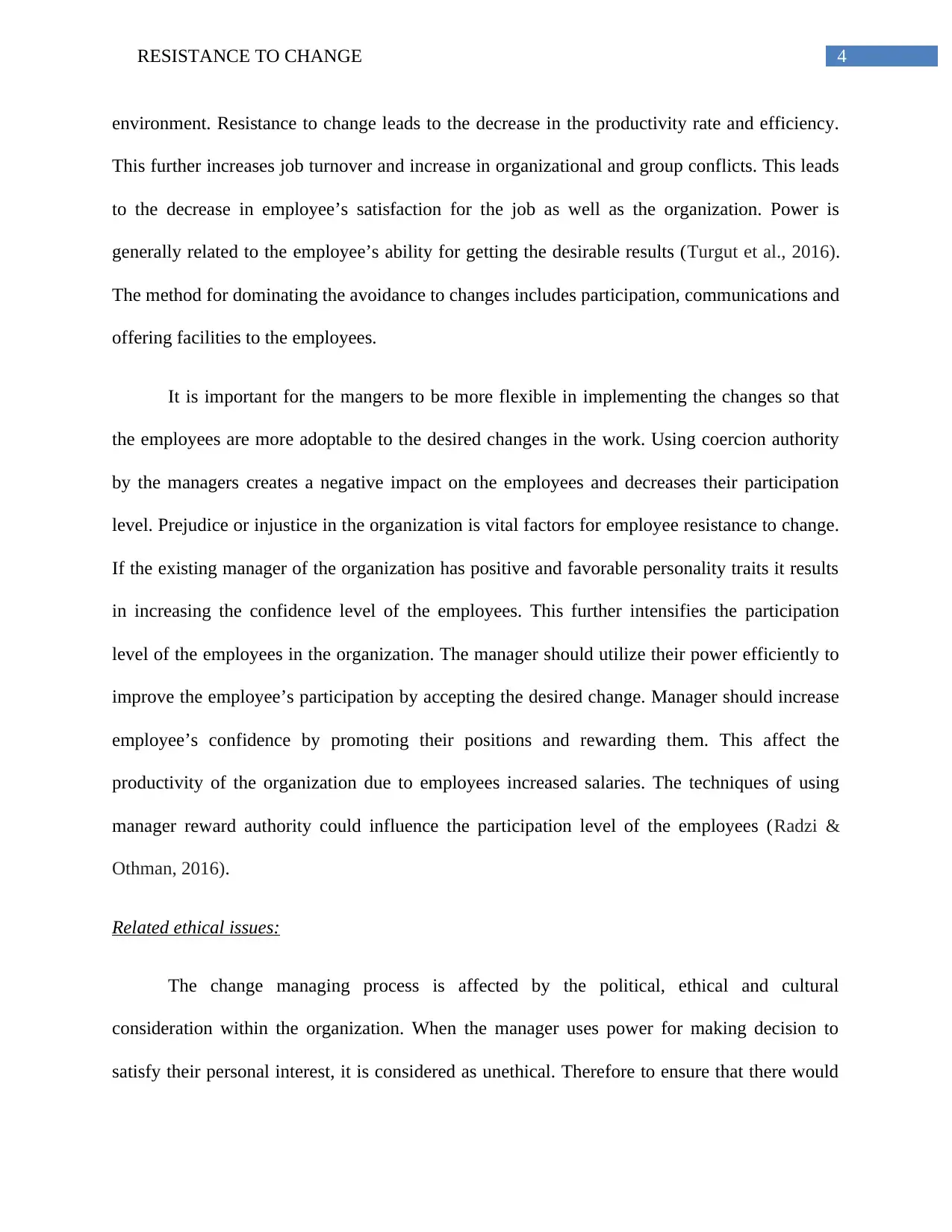
4RESISTANCE TO CHANGE
environment. Resistance to change leads to the decrease in the productivity rate and efficiency.
This further increases job turnover and increase in organizational and group conflicts. This leads
to the decrease in employee’s satisfaction for the job as well as the organization. Power is
generally related to the employee’s ability for getting the desirable results (Turgut et al., 2016).
The method for dominating the avoidance to changes includes participation, communications and
offering facilities to the employees.
It is important for the mangers to be more flexible in implementing the changes so that
the employees are more adoptable to the desired changes in the work. Using coercion authority
by the managers creates a negative impact on the employees and decreases their participation
level. Prejudice or injustice in the organization is vital factors for employee resistance to change.
If the existing manager of the organization has positive and favorable personality traits it results
in increasing the confidence level of the employees. This further intensifies the participation
level of the employees in the organization. The manager should utilize their power efficiently to
improve the employee’s participation by accepting the desired change. Manager should increase
employee’s confidence by promoting their positions and rewarding them. This affect the
productivity of the organization due to employees increased salaries. The techniques of using
manager reward authority could influence the participation level of the employees (Radzi &
Othman, 2016).
Related ethical issues:
The change managing process is affected by the political, ethical and cultural
consideration within the organization. When the manager uses power for making decision to
satisfy their personal interest, it is considered as unethical. Therefore to ensure that there would
environment. Resistance to change leads to the decrease in the productivity rate and efficiency.
This further increases job turnover and increase in organizational and group conflicts. This leads
to the decrease in employee’s satisfaction for the job as well as the organization. Power is
generally related to the employee’s ability for getting the desirable results (Turgut et al., 2016).
The method for dominating the avoidance to changes includes participation, communications and
offering facilities to the employees.
It is important for the mangers to be more flexible in implementing the changes so that
the employees are more adoptable to the desired changes in the work. Using coercion authority
by the managers creates a negative impact on the employees and decreases their participation
level. Prejudice or injustice in the organization is vital factors for employee resistance to change.
If the existing manager of the organization has positive and favorable personality traits it results
in increasing the confidence level of the employees. This further intensifies the participation
level of the employees in the organization. The manager should utilize their power efficiently to
improve the employee’s participation by accepting the desired change. Manager should increase
employee’s confidence by promoting their positions and rewarding them. This affect the
productivity of the organization due to employees increased salaries. The techniques of using
manager reward authority could influence the participation level of the employees (Radzi &
Othman, 2016).
Related ethical issues:
The change managing process is affected by the political, ethical and cultural
consideration within the organization. When the manager uses power for making decision to
satisfy their personal interest, it is considered as unethical. Therefore to ensure that there would
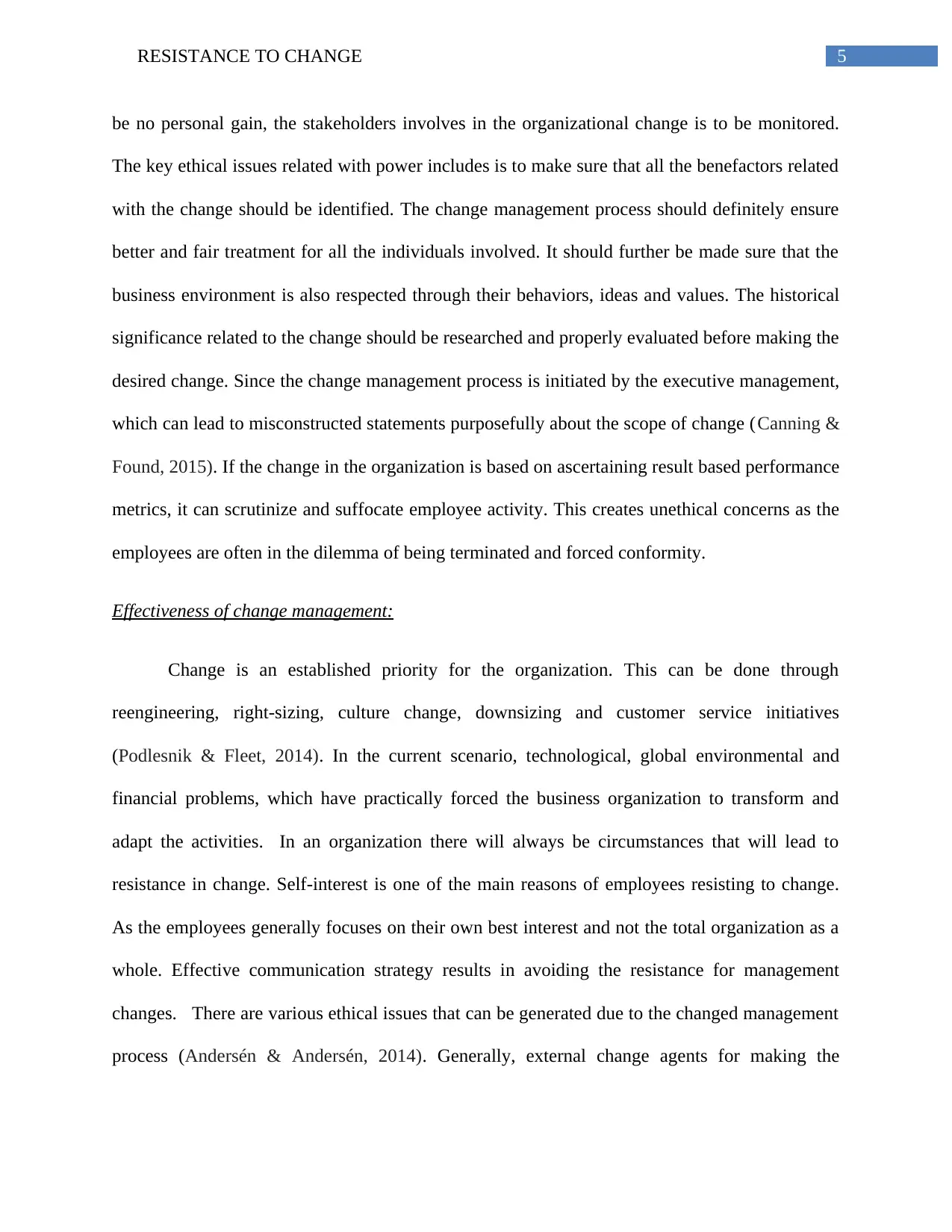
5RESISTANCE TO CHANGE
be no personal gain, the stakeholders involves in the organizational change is to be monitored.
The key ethical issues related with power includes is to make sure that all the benefactors related
with the change should be identified. The change management process should definitely ensure
better and fair treatment for all the individuals involved. It should further be made sure that the
business environment is also respected through their behaviors, ideas and values. The historical
significance related to the change should be researched and properly evaluated before making the
desired change. Since the change management process is initiated by the executive management,
which can lead to misconstructed statements purposefully about the scope of change (Canning &
Found, 2015). If the change in the organization is based on ascertaining result based performance
metrics, it can scrutinize and suffocate employee activity. This creates unethical concerns as the
employees are often in the dilemma of being terminated and forced conformity.
Effectiveness of change management:
Change is an established priority for the organization. This can be done through
reengineering, right-sizing, culture change, downsizing and customer service initiatives
(Podlesnik & Fleet, 2014). In the current scenario, technological, global environmental and
financial problems, which have practically forced the business organization to transform and
adapt the activities. In an organization there will always be circumstances that will lead to
resistance in change. Self-interest is one of the main reasons of employees resisting to change.
As the employees generally focuses on their own best interest and not the total organization as a
whole. Effective communication strategy results in avoiding the resistance for management
changes. There are various ethical issues that can be generated due to the changed management
process (Andersén & Andersén, 2014). Generally, external change agents for making the
be no personal gain, the stakeholders involves in the organizational change is to be monitored.
The key ethical issues related with power includes is to make sure that all the benefactors related
with the change should be identified. The change management process should definitely ensure
better and fair treatment for all the individuals involved. It should further be made sure that the
business environment is also respected through their behaviors, ideas and values. The historical
significance related to the change should be researched and properly evaluated before making the
desired change. Since the change management process is initiated by the executive management,
which can lead to misconstructed statements purposefully about the scope of change (Canning &
Found, 2015). If the change in the organization is based on ascertaining result based performance
metrics, it can scrutinize and suffocate employee activity. This creates unethical concerns as the
employees are often in the dilemma of being terminated and forced conformity.
Effectiveness of change management:
Change is an established priority for the organization. This can be done through
reengineering, right-sizing, culture change, downsizing and customer service initiatives
(Podlesnik & Fleet, 2014). In the current scenario, technological, global environmental and
financial problems, which have practically forced the business organization to transform and
adapt the activities. In an organization there will always be circumstances that will lead to
resistance in change. Self-interest is one of the main reasons of employees resisting to change.
As the employees generally focuses on their own best interest and not the total organization as a
whole. Effective communication strategy results in avoiding the resistance for management
changes. There are various ethical issues that can be generated due to the changed management
process (Andersén & Andersén, 2014). Generally, external change agents for making the
⊘ This is a preview!⊘
Do you want full access?
Subscribe today to unlock all pages.

Trusted by 1+ million students worldwide
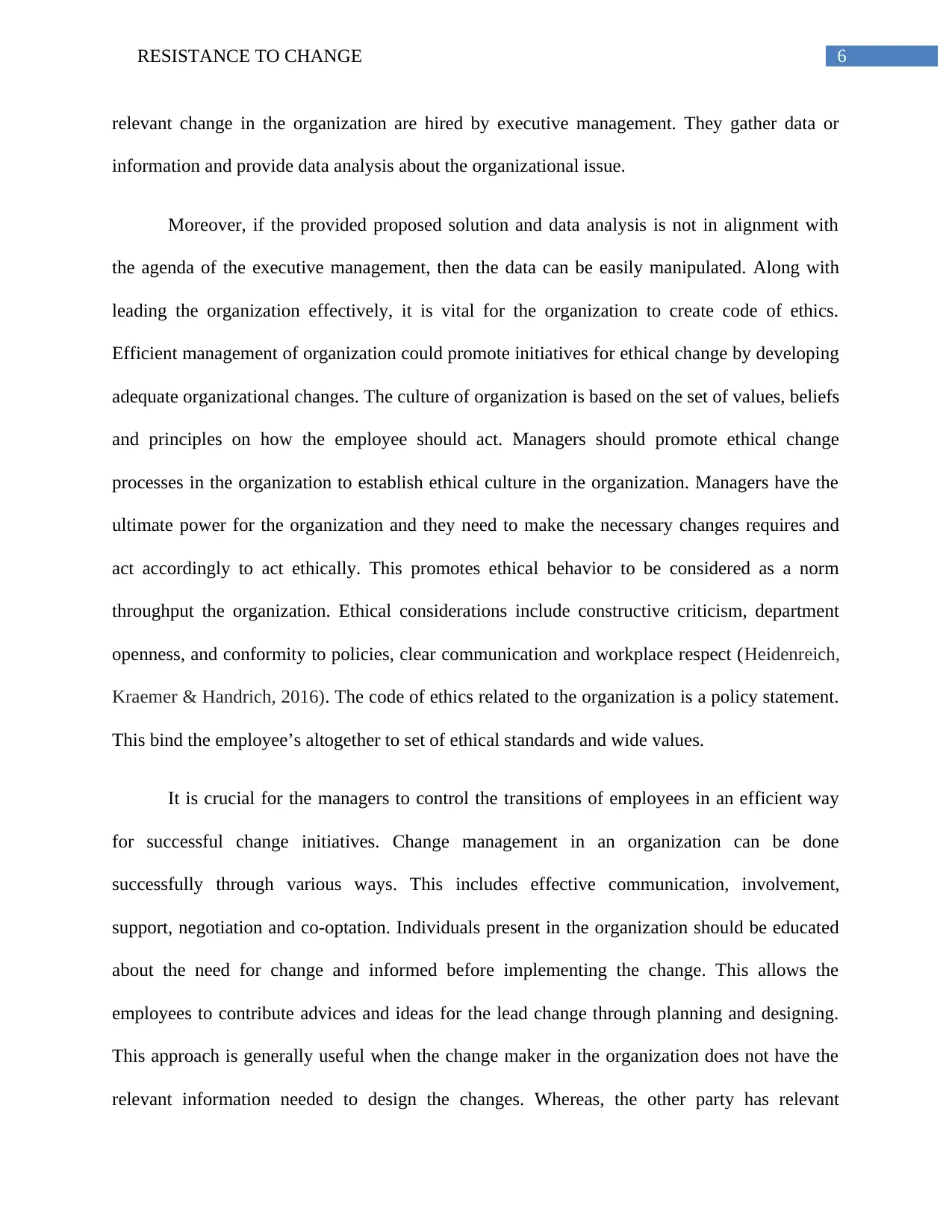
6RESISTANCE TO CHANGE
relevant change in the organization are hired by executive management. They gather data or
information and provide data analysis about the organizational issue.
Moreover, if the provided proposed solution and data analysis is not in alignment with
the agenda of the executive management, then the data can be easily manipulated. Along with
leading the organization effectively, it is vital for the organization to create code of ethics.
Efficient management of organization could promote initiatives for ethical change by developing
adequate organizational changes. The culture of organization is based on the set of values, beliefs
and principles on how the employee should act. Managers should promote ethical change
processes in the organization to establish ethical culture in the organization. Managers have the
ultimate power for the organization and they need to make the necessary changes requires and
act accordingly to act ethically. This promotes ethical behavior to be considered as a norm
throughput the organization. Ethical considerations include constructive criticism, department
openness, and conformity to policies, clear communication and workplace respect (Heidenreich,
Kraemer & Handrich, 2016). The code of ethics related to the organization is a policy statement.
This bind the employee’s altogether to set of ethical standards and wide values.
It is crucial for the managers to control the transitions of employees in an efficient way
for successful change initiatives. Change management in an organization can be done
successfully through various ways. This includes effective communication, involvement,
support, negotiation and co-optation. Individuals present in the organization should be educated
about the need for change and informed before implementing the change. This allows the
employees to contribute advices and ideas for the lead change through planning and designing.
This approach is generally useful when the change maker in the organization does not have the
relevant information needed to design the changes. Whereas, the other party has relevant
relevant change in the organization are hired by executive management. They gather data or
information and provide data analysis about the organizational issue.
Moreover, if the provided proposed solution and data analysis is not in alignment with
the agenda of the executive management, then the data can be easily manipulated. Along with
leading the organization effectively, it is vital for the organization to create code of ethics.
Efficient management of organization could promote initiatives for ethical change by developing
adequate organizational changes. The culture of organization is based on the set of values, beliefs
and principles on how the employee should act. Managers should promote ethical change
processes in the organization to establish ethical culture in the organization. Managers have the
ultimate power for the organization and they need to make the necessary changes requires and
act accordingly to act ethically. This promotes ethical behavior to be considered as a norm
throughput the organization. Ethical considerations include constructive criticism, department
openness, and conformity to policies, clear communication and workplace respect (Heidenreich,
Kraemer & Handrich, 2016). The code of ethics related to the organization is a policy statement.
This bind the employee’s altogether to set of ethical standards and wide values.
It is crucial for the managers to control the transitions of employees in an efficient way
for successful change initiatives. Change management in an organization can be done
successfully through various ways. This includes effective communication, involvement,
support, negotiation and co-optation. Individuals present in the organization should be educated
about the need for change and informed before implementing the change. This allows the
employees to contribute advices and ideas for the lead change through planning and designing.
This approach is generally useful when the change maker in the organization does not have the
relevant information needed to design the changes. Whereas, the other party has relevant
Paraphrase This Document
Need a fresh take? Get an instant paraphrase of this document with our AI Paraphraser
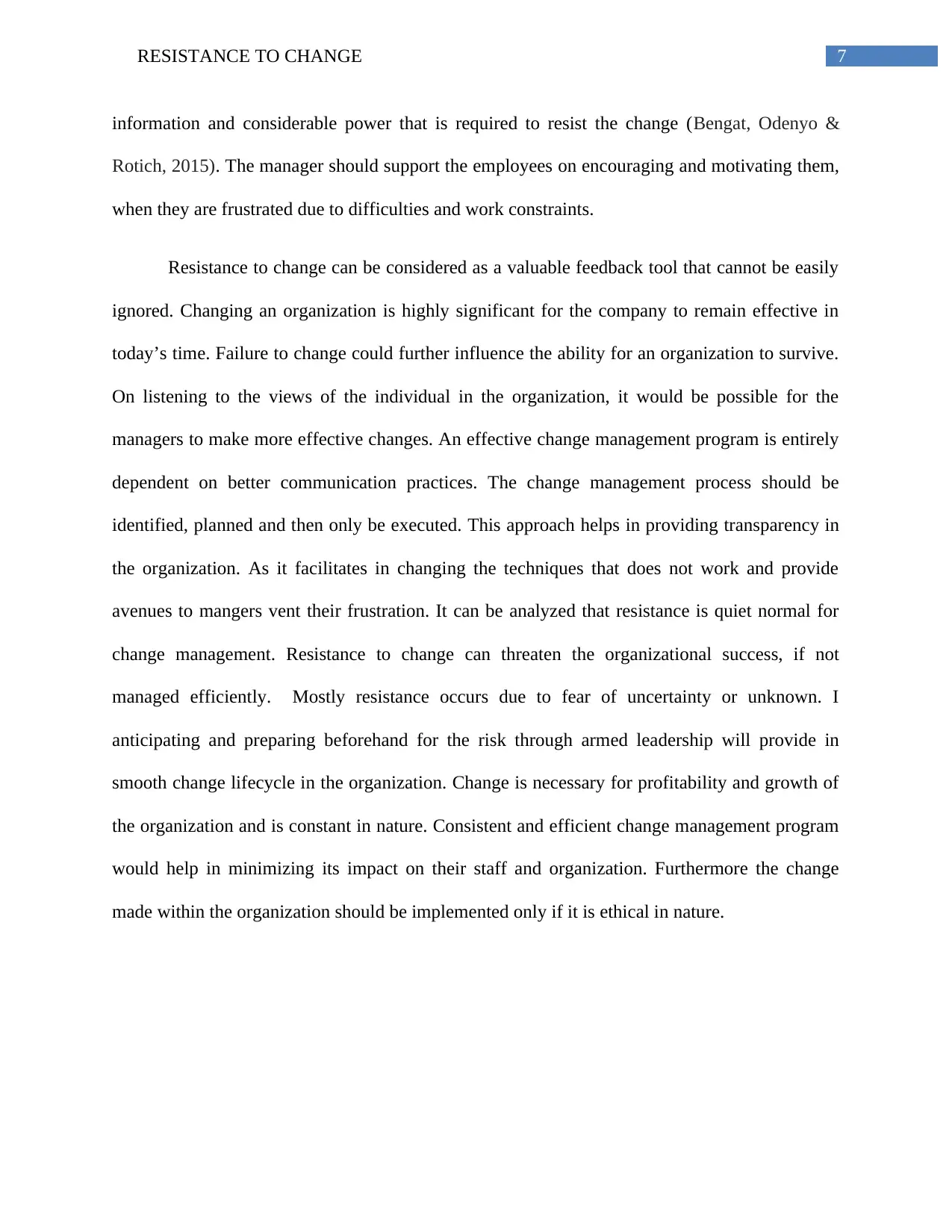
7RESISTANCE TO CHANGE
information and considerable power that is required to resist the change (Bengat, Odenyo &
Rotich, 2015). The manager should support the employees on encouraging and motivating them,
when they are frustrated due to difficulties and work constraints.
Resistance to change can be considered as a valuable feedback tool that cannot be easily
ignored. Changing an organization is highly significant for the company to remain effective in
today’s time. Failure to change could further influence the ability for an organization to survive.
On listening to the views of the individual in the organization, it would be possible for the
managers to make more effective changes. An effective change management program is entirely
dependent on better communication practices. The change management process should be
identified, planned and then only be executed. This approach helps in providing transparency in
the organization. As it facilitates in changing the techniques that does not work and provide
avenues to mangers vent their frustration. It can be analyzed that resistance is quiet normal for
change management. Resistance to change can threaten the organizational success, if not
managed efficiently. Mostly resistance occurs due to fear of uncertainty or unknown. I
anticipating and preparing beforehand for the risk through armed leadership will provide in
smooth change lifecycle in the organization. Change is necessary for profitability and growth of
the organization and is constant in nature. Consistent and efficient change management program
would help in minimizing its impact on their staff and organization. Furthermore the change
made within the organization should be implemented only if it is ethical in nature.
information and considerable power that is required to resist the change (Bengat, Odenyo &
Rotich, 2015). The manager should support the employees on encouraging and motivating them,
when they are frustrated due to difficulties and work constraints.
Resistance to change can be considered as a valuable feedback tool that cannot be easily
ignored. Changing an organization is highly significant for the company to remain effective in
today’s time. Failure to change could further influence the ability for an organization to survive.
On listening to the views of the individual in the organization, it would be possible for the
managers to make more effective changes. An effective change management program is entirely
dependent on better communication practices. The change management process should be
identified, planned and then only be executed. This approach helps in providing transparency in
the organization. As it facilitates in changing the techniques that does not work and provide
avenues to mangers vent their frustration. It can be analyzed that resistance is quiet normal for
change management. Resistance to change can threaten the organizational success, if not
managed efficiently. Mostly resistance occurs due to fear of uncertainty or unknown. I
anticipating and preparing beforehand for the risk through armed leadership will provide in
smooth change lifecycle in the organization. Change is necessary for profitability and growth of
the organization and is constant in nature. Consistent and efficient change management program
would help in minimizing its impact on their staff and organization. Furthermore the change
made within the organization should be implemented only if it is ethical in nature.
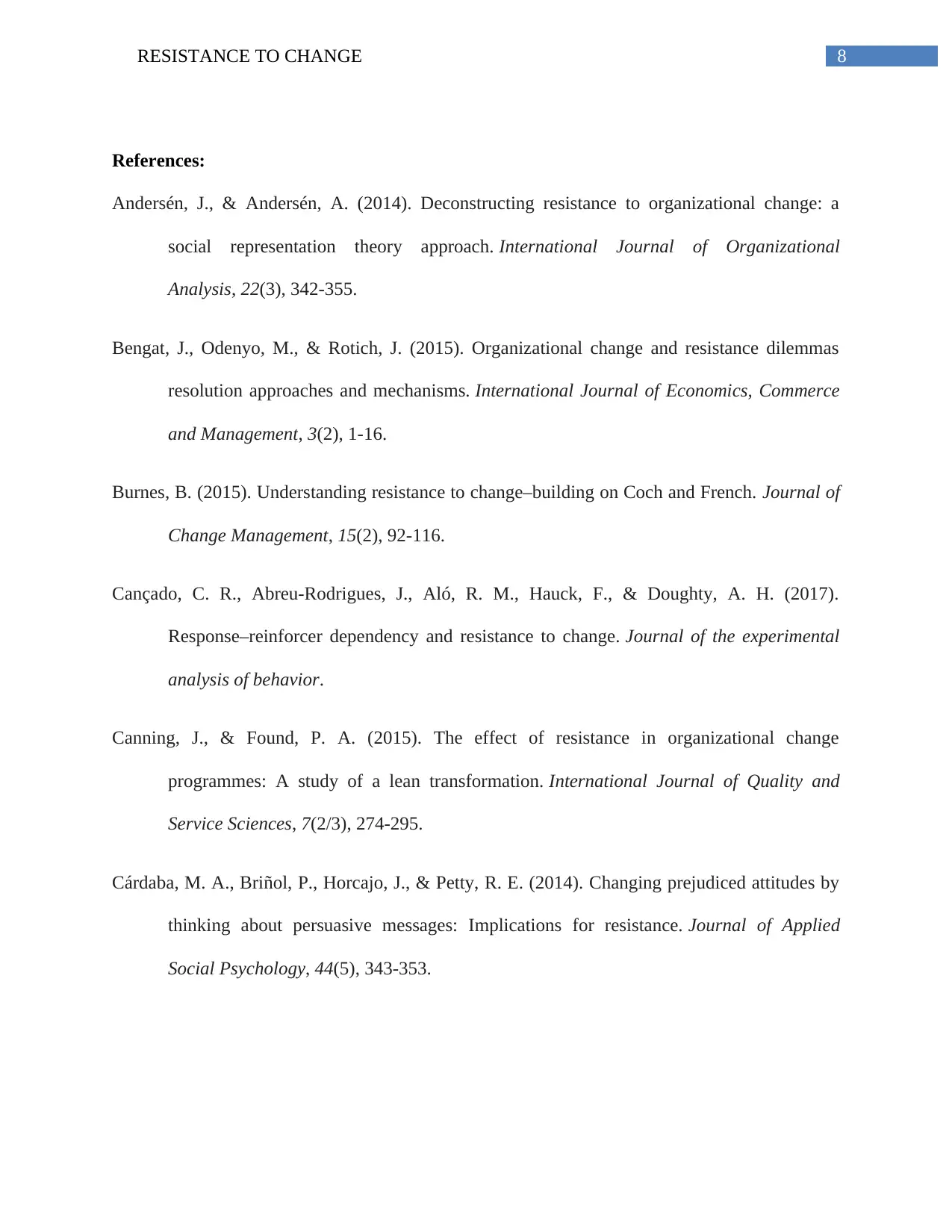
8RESISTANCE TO CHANGE
References:
Andersén, J., & Andersén, A. (2014). Deconstructing resistance to organizational change: a
social representation theory approach. International Journal of Organizational
Analysis, 22(3), 342-355.
Bengat, J., Odenyo, M., & Rotich, J. (2015). Organizational change and resistance dilemmas
resolution approaches and mechanisms. International Journal of Economics, Commerce
and Management, 3(2), 1-16.
Burnes, B. (2015). Understanding resistance to change–building on Coch and French. Journal of
Change Management, 15(2), 92-116.
Cançado, C. R., Abreu‐Rodrigues, J., Aló, R. M., Hauck, F., & Doughty, A. H. (2017).
Response–reinforcer dependency and resistance to change. Journal of the experimental
analysis of behavior.
Canning, J., & Found, P. A. (2015). The effect of resistance in organizational change
programmes: A study of a lean transformation. International Journal of Quality and
Service Sciences, 7(2/3), 274-295.
Cárdaba, M. A., Briñol, P., Horcajo, J., & Petty, R. E. (2014). Changing prejudiced attitudes by
thinking about persuasive messages: Implications for resistance. Journal of Applied
Social Psychology, 44(5), 343-353.
References:
Andersén, J., & Andersén, A. (2014). Deconstructing resistance to organizational change: a
social representation theory approach. International Journal of Organizational
Analysis, 22(3), 342-355.
Bengat, J., Odenyo, M., & Rotich, J. (2015). Organizational change and resistance dilemmas
resolution approaches and mechanisms. International Journal of Economics, Commerce
and Management, 3(2), 1-16.
Burnes, B. (2015). Understanding resistance to change–building on Coch and French. Journal of
Change Management, 15(2), 92-116.
Cançado, C. R., Abreu‐Rodrigues, J., Aló, R. M., Hauck, F., & Doughty, A. H. (2017).
Response–reinforcer dependency and resistance to change. Journal of the experimental
analysis of behavior.
Canning, J., & Found, P. A. (2015). The effect of resistance in organizational change
programmes: A study of a lean transformation. International Journal of Quality and
Service Sciences, 7(2/3), 274-295.
Cárdaba, M. A., Briñol, P., Horcajo, J., & Petty, R. E. (2014). Changing prejudiced attitudes by
thinking about persuasive messages: Implications for resistance. Journal of Applied
Social Psychology, 44(5), 343-353.
⊘ This is a preview!⊘
Do you want full access?
Subscribe today to unlock all pages.

Trusted by 1+ million students worldwide
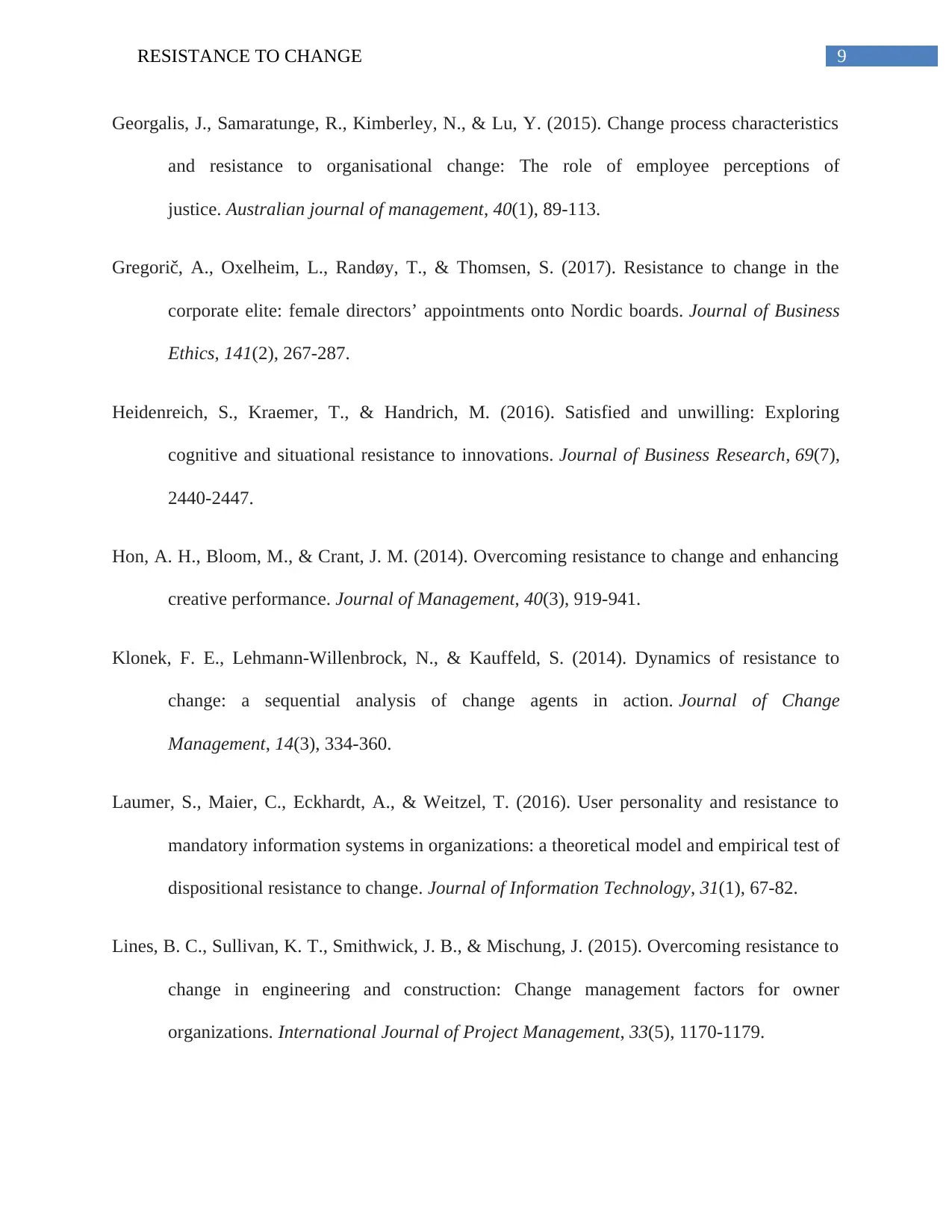
9RESISTANCE TO CHANGE
Georgalis, J., Samaratunge, R., Kimberley, N., & Lu, Y. (2015). Change process characteristics
and resistance to organisational change: The role of employee perceptions of
justice. Australian journal of management, 40(1), 89-113.
Gregorič, A., Oxelheim, L., Randøy, T., & Thomsen, S. (2017). Resistance to change in the
corporate elite: female directors’ appointments onto Nordic boards. Journal of Business
Ethics, 141(2), 267-287.
Heidenreich, S., Kraemer, T., & Handrich, M. (2016). Satisfied and unwilling: Exploring
cognitive and situational resistance to innovations. Journal of Business Research, 69(7),
2440-2447.
Hon, A. H., Bloom, M., & Crant, J. M. (2014). Overcoming resistance to change and enhancing
creative performance. Journal of Management, 40(3), 919-941.
Klonek, F. E., Lehmann-Willenbrock, N., & Kauffeld, S. (2014). Dynamics of resistance to
change: a sequential analysis of change agents in action. Journal of Change
Management, 14(3), 334-360.
Laumer, S., Maier, C., Eckhardt, A., & Weitzel, T. (2016). User personality and resistance to
mandatory information systems in organizations: a theoretical model and empirical test of
dispositional resistance to change. Journal of Information Technology, 31(1), 67-82.
Lines, B. C., Sullivan, K. T., Smithwick, J. B., & Mischung, J. (2015). Overcoming resistance to
change in engineering and construction: Change management factors for owner
organizations. International Journal of Project Management, 33(5), 1170-1179.
Georgalis, J., Samaratunge, R., Kimberley, N., & Lu, Y. (2015). Change process characteristics
and resistance to organisational change: The role of employee perceptions of
justice. Australian journal of management, 40(1), 89-113.
Gregorič, A., Oxelheim, L., Randøy, T., & Thomsen, S. (2017). Resistance to change in the
corporate elite: female directors’ appointments onto Nordic boards. Journal of Business
Ethics, 141(2), 267-287.
Heidenreich, S., Kraemer, T., & Handrich, M. (2016). Satisfied and unwilling: Exploring
cognitive and situational resistance to innovations. Journal of Business Research, 69(7),
2440-2447.
Hon, A. H., Bloom, M., & Crant, J. M. (2014). Overcoming resistance to change and enhancing
creative performance. Journal of Management, 40(3), 919-941.
Klonek, F. E., Lehmann-Willenbrock, N., & Kauffeld, S. (2014). Dynamics of resistance to
change: a sequential analysis of change agents in action. Journal of Change
Management, 14(3), 334-360.
Laumer, S., Maier, C., Eckhardt, A., & Weitzel, T. (2016). User personality and resistance to
mandatory information systems in organizations: a theoretical model and empirical test of
dispositional resistance to change. Journal of Information Technology, 31(1), 67-82.
Lines, B. C., Sullivan, K. T., Smithwick, J. B., & Mischung, J. (2015). Overcoming resistance to
change in engineering and construction: Change management factors for owner
organizations. International Journal of Project Management, 33(5), 1170-1179.
Paraphrase This Document
Need a fresh take? Get an instant paraphrase of this document with our AI Paraphraser
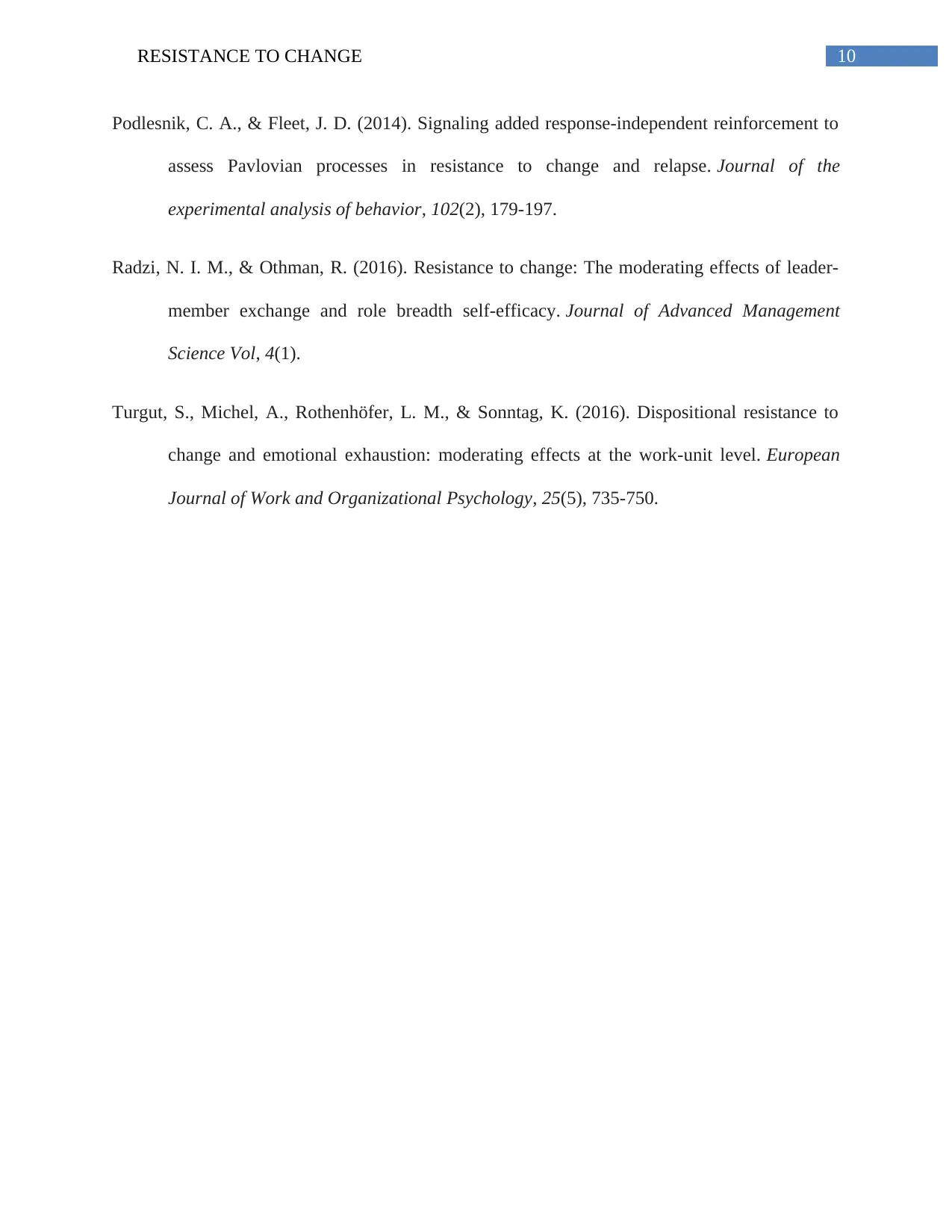
10RESISTANCE TO CHANGE
Podlesnik, C. A., & Fleet, J. D. (2014). Signaling added response‐independent reinforcement to
assess Pavlovian processes in resistance to change and relapse. Journal of the
experimental analysis of behavior, 102(2), 179-197.
Radzi, N. I. M., & Othman, R. (2016). Resistance to change: The moderating effects of leader-
member exchange and role breadth self-efficacy. Journal of Advanced Management
Science Vol, 4(1).
Turgut, S., Michel, A., Rothenhöfer, L. M., & Sonntag, K. (2016). Dispositional resistance to
change and emotional exhaustion: moderating effects at the work-unit level. European
Journal of Work and Organizational Psychology, 25(5), 735-750.
Podlesnik, C. A., & Fleet, J. D. (2014). Signaling added response‐independent reinforcement to
assess Pavlovian processes in resistance to change and relapse. Journal of the
experimental analysis of behavior, 102(2), 179-197.
Radzi, N. I. M., & Othman, R. (2016). Resistance to change: The moderating effects of leader-
member exchange and role breadth self-efficacy. Journal of Advanced Management
Science Vol, 4(1).
Turgut, S., Michel, A., Rothenhöfer, L. M., & Sonntag, K. (2016). Dispositional resistance to
change and emotional exhaustion: moderating effects at the work-unit level. European
Journal of Work and Organizational Psychology, 25(5), 735-750.
1 out of 11
Related Documents
Your All-in-One AI-Powered Toolkit for Academic Success.
+13062052269
info@desklib.com
Available 24*7 on WhatsApp / Email
![[object Object]](/_next/static/media/star-bottom.7253800d.svg)
Unlock your academic potential
Copyright © 2020–2025 A2Z Services. All Rights Reserved. Developed and managed by ZUCOL.





